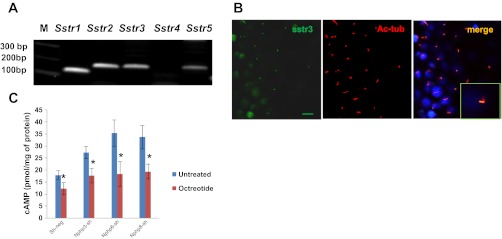Fig. 5.
Octreotide treatment inhibits elevated cAMP levels upon Nphp knockdown in IMCD3 cells. A: IMCD3 cells express somatostatin receptors. Designed primers for five somatostatin receptors (Sstr1, Sstr2, Sstr3, Sstr4, and Sstr5) and cDNAs from IMCD3 cells were used to analyze mRNA expression by the RT-PCR method. Agarose gel electrophoresis data revealed that all five somatostatin receptors except Sstr4 were abundant in IMCD3 cells. M, molecular weight marker. B: somatostatin receptor 3 (Sstr3) is localized to the cilia. Ciliated IMCD3 cells were stained with acetylated α-tubulin (Ac-tub) and Sstr3 antibodies. Confocal immunofluorescence images were taken for cilia (red) and Sstr3 (green) localization. Merged image revealed Sstr3 localization at the cilia. Magnified image was shown in the inset. C: bar diagram represents elevated intracellular cAMP levels upon Nphp3, Nphp6, and Nphp8 knockdown compared with the control sh-neg cells. Treatment of octreotide (2 μM) significantly reduced cAMP levels. Enzyme-linked immunosorbent assay was performed on triplicate samples using the Direct Cyclic AMP Enzyme Immunoassay kit (Arbor Assays). Statistical significance level was determined by t-test using means and SDs of triplicate samples. Two-tailed t-test was performed to test the significance of difference using means and SDs. *Significance level (P < 0.05).

